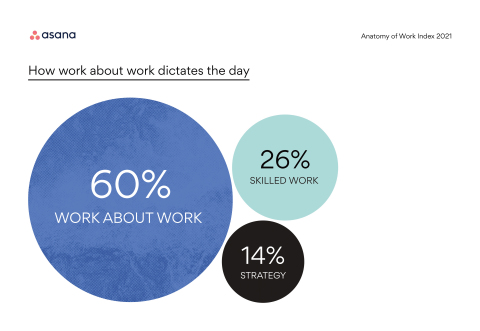Asana Anatomy of Work Index 2021: Work About Work Is Dominating in a Distributed World
Asana (NYSE: ASAN) has released its annual Anatomy of Work Index 2021, highlighting that global workers are losing 60% of their time on work coordination, with larger organizations experiencing increased time loss. Surveying over 13,000 knowledge workers, key findings reveal that 87% of employees are working late, and 36% of deadlines are missed weekly. Notably, workers report higher instances of burnout and imposter syndrome. Asana emphasizes the need for clear processes to improve productivity and resilience moving forward.
- Asana’s platform can help address the productivity challenges revealed in the survey.
- The company has a vast customer base with over 89,000 paying organizations globally.
- 87% of employees are working late, indicating employee overload and burnout risk.
- 36% of deadlines are missed weekly, reflecting issues in work processes and expectations.
Insights
Analyzing...
Asana, Inc. (NYSE: ASAN), a leading work management platform for teams, today released its annual Anatomy of Work Index, an in-depth analysis into how people spend time at work and the factors shaping those habits. Despite organizations’ best efforts to recreate what worked in the office in a remote setting, global workers are losing 60 percent of their time on work coordination rather than the skilled, strategic jobs they’ve been hired to do.

Organizations of every size, and across all industries, are losing
Organizations of every size, and across all industries, are losing countless hours to work about work - the time wasted on searching for information, switching between apps, and holding status meetings. As enterprises grow, so does their work about work - organizations of 5,000+ employees lose
Conducted by Sapio Research on behalf of Asana, the Anatomy of Work Index 2021, surveyed the behaviors and attitudes of 13,123 knowledge workers across Australia/New Zealand; France; Germany; Japan; Singapore; the U.K.; and the U.S., to explore how individuals, teams, and entire organizations can bring clarity to the chaos of work, reset for resilience, and flourish as they move forward.
The Productivity Paradox of Distributed Work
In a year marked by distraction and disruption, lack of clarity on roles, ownership and purpose of deliverables, combined with more messages, meetings and tools to navigate, is fueling troubling trends.
An overwhelming 87 percent of employees are working late—455 hours every year, compared to 242 hours in 2019. And while teams are having fewer ad-hoc conversations, this hasn’t resulted in shorter working days. Casual chats have been replaced with unnecessary meetings, costing individuals 157 hours per year. Additional key global findings include:
-
One in four (
26% ) deadlines are missed each week as a result of unrealistic expectations and unclear processes. -
Teams are spending
30% more time on duplication of work and work deemed a waste of time year-over-year. New hires spend nearly twice as much time on duplicated work as their tenured teammates. - As the work day extends, 3 in 4 employees are struggling to disconnect from work with 7 in 10 experiencing burnout at least once in 2020.
-
Nearly two-thirds, (
62% ) experienced imposter syndrome in 2020.-
Nearly
80% of workers who started a new job during the pandemic report experiencing imposter syndrome. -
Experiences of imposter syndrome are also more common for parents and caregivers with children at home (
67% ) compared to those without (57% ).
-
Nearly
-
Around the world, the top three barriers to productivity are:
- Having too much work to do
- Having to respond to too many emails and messages pings
- Having too many meetings and video calls
“Before COVID-19, there was a rapidly rising business imperative for increased clarity and alignment. Clarity is really difficult for teams to achieve even when they’re in the office, but it’s particularly challenging when working remotely,” said Dustin Moskovitz, CEO, Asana. “Going forward, some companies will continue working from home, some will return to the office, and some will do everything else in between. Across that entire spectrum, Asana has an important role to play in driving clarity for teams, no matter where they do their work.”
Despite all countries continuing to grapple with the unique set of work challenges in the COVID-19 era, the survey findings illustrate the vast differences experienced across timezones:
- Employees in Australia and New Zealand are more likely than average to feel heard by their organization, and are also more optimistic about the year ahead in work.
-
French workers are spending the most time on work about work each week (
66% of their time), and are finding it hardest to disconnect from work at the end of the day. -
Only
13% of German employees feel completely heard by their organization, with one in three (32% ) wanting more flexible hours when working remotely. - Japanese workers rely on written communication more than any other country and, as a result, grapple with messages and emails as their number one barrier to productivity.
- Knowledge workers in Singapore have the longest working week (over 42 hours) and are the country most likely to work beyond 5:30 p.m.
- The U.K. misses the fewest deadlines out of all countries, but indexes high on likelihood to have experienced imposter syndrome in the past year.
-
Nearly 9 in 10 (
89% ) knowledge workers in the U.S. experienced burnout in 2020, with employees missing36% of all deadlines each week - the highest of all countries surveyed.
Leveling Up Work in the Year Ahead
The new year marks a chance for new beginnings. It’s also an opportunity to better equip individuals and teams by providing meaningful job engagement and opportunities to accelerate.
Two-thirds of respondents believe the skills required to do their job will evolve in 2021 with IT and technology proficiency, confidence, and leadership development cited as the top three areas for personal growth. Across all employees surveyed, 73 percent believe that organizations can be more resilient in 2021 if plans are flexible.
“Over the past year, there has been a dramatic shift in the way teams and organizations work. ‘Work about work’ has skyrocketed in the form of unproductive meetings and calls and an increase in email and chat usage, especially during evenings and weekends. Considering the continued rise in burnout numbers we have been seeing, our research suggests that unless organizations take a proactive approach, productivity is projected to plummet in 2021,” said Dr. Sahar Yousef, Cognitive Neuroscientist, UC Berkeley. “Organizations and leaders must address these issues head-on by adopting clear processes on how work gets done, so they can thrive in the year ahead and come out more resilient and aligned than before.”
Asana’s Anatomy of Work Index 2021 and more information about the findings are available for download: https://asana.com/anatomy.
About Asana
Asana helps teams orchestrate their work, from small projects to strategic initiatives. Headquartered in San Francisco, CA, Asana has more than 89,000 paying organizations and millions of free organizations across 190 countries. Global customers such as Accenture, Danone, Sky, Spotify and Viessmann rely on Asana to manage everything from company objectives to digital transformation to product launches and marketing campaigns. For more information, visit www.asana.com.
Research Methodology
In October 2020, quantitative research was conducted by Sapio Research on behalf of Asana, to understand how people spend time at work. Asana and Sapio Research co-designed the questionnaire and surveyed the behaviors and attitudes of 13,123 knowledge workers across Australia/New Zealand; France; Germany; Japan; Singapore; the U.K. and the U.S.
The study defined a knowledge worker as a professional who spends the majority of their time in an office, co-work space, or working from home and spends
Faculty Partner
To generate these insights, Asana partnered with Dr. Sahar Yousef, a cognitive neuroscientist and faculty at UC Berkeley’s Haas School of Business. She runs the Becoming Superhuman Lab, which studies the science of productivity and helps busy leaders and their teams get their most important work done, in less time, with less stress.
View source version on businesswire.com: https://www.businesswire.com/news/home/20210114005374/en/







